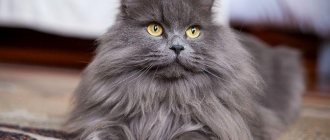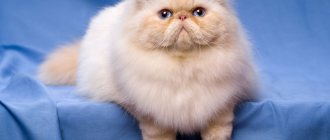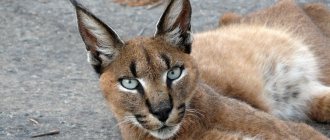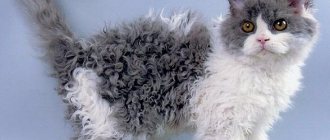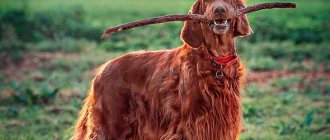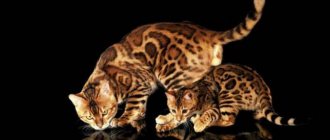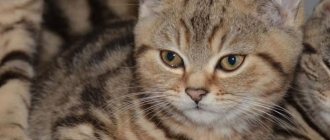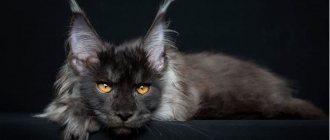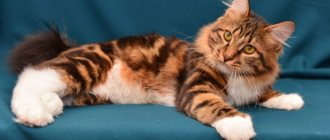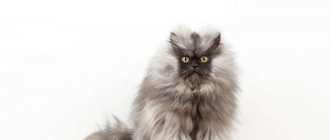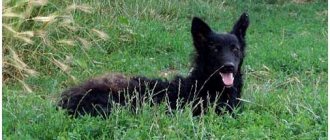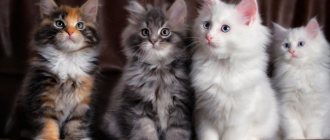Gray or, as they are usually called, blue cats are a fairly common type of color, which is characterized by a special nobility and a variety of unique shades. It is found both among purebred and ordinary domestic cats. It can be either uniform along the entire length of the fur or smoky - this means that the upper part of each hair of the animal is colored darker than the lower, and looks as if a dark veil has been thrown over the cat. The dark part of the hair can be even smaller, then the color is called “shaded” or “chinchilla”. What features does a blue cat have and what should you expect when inviting him into your home?
About color
The solid gray uniform color of cats is usually called blue. This color symbolizes the intangible, spiritual world, and blue cats are considered its guides. They are recognized as the best healers and protectors of humans, bringing love and peace to the home. This shade of fur in a cat is determined by the gene that carries the black color B, diluted by the recessive allele d. That is, the “blue” color is essentially a lightened charcoal color.
There are many variations in the genotype of gray cats, it depends on the combination of genes B and d in a recessive or dominant, homo- or heterozygous form. That is why there are such gray colors as chinchilla, mackerel, tabby, solid, smoky, agouti. It all depends on the degree to which each hair is painted black and the alternation of charcoal and white stripes on it.
Also read: TOP 10 evil cat breeds.
Health
Thanks to the genes of their ancestors, Anatolian cats are very strong and have excellent health; their immunity copes well with parasites, viruses and infections. These troubles do not happen to them often. And serious illnesses even more rarely affect representatives of this breed. If you take proper care, your cat can live with you for more than 15 years.
If your plans do not include breeding the breed, it is better to castrate or sterilize your pet. Sterilize after the animal is 8 months old, and preferably up to a year. The maximum age for this procedure is 2 years; after this milestone, health problems may arise. Castration is carried out from 10 months to 2 years
It is important to carry out these manipulations before the cat matures and its habits are formed. In addition, the younger the cat, the faster he will get back on his feet.
Early surgery is also not recommended, otherwise it will cause developmental delay.
After the operation is done, you need to provide your pet with adequate care to prevent possible complications. Entrust your little friend only to a trusted doctor, and after the operation follow these rules:
- the cat needs peace, rid the animal of noise;
- there is a danger that the pet will lick the seams too actively and they will come apart, so provide him with a special belt-blanket;
- food can be given only after 12 hours;
- check the condition of the seams daily, treat them with Chlorhexidine or peroxide;
- stay nearby, don’t let them move too actively;
- You can give an anesthetic if the veterinarian gives the go-ahead and indicates the dosage.
To purchase an Anatolian cat, you need to contact only trusted breeders and nurseries. Anatolians are bred in Greece, Germany, Holland, Ukraine, Belarus, Russia. There are no nurseries in our country, but there are quite a few breeders specializing in this breed.
You can learn more about the intellectual abilities of Turkish cats from the video below.
Common Breeds
Blue coat color is required only for some breeds. Usually all its representatives have bright green eyes; very rarely they can be of a topaz shade.
| Name | Description |
| Korat | Sociable, energetic and talkative small pets. The short blue coat has no undercoat and lies close to the body. |
| Chartreuse | A very beautiful animal with short and seemingly printed hair. But he has a rather capricious and jealous character. |
| Russian blue | One of the oldest cat breeds in the Arkhangelsk province. These pets are distinguished by their silence, restraint and deep love for people. Still one of the most popular varieties. |
| Nibelung | “Child of the Mists” is very similar to the Russian Blue in its behavior and appearance. They only have beautiful and shiny wool of the semi-long type. They differ in that they meow silently. They are almost never found in Russia. One of the most sought after and beloved animals in the world. |
Cat breeds in which gray coloring is not required, but is one of the main ones:
| Name | Description |
| British Shorthair | There are more than 200 shades, the main one being gray in various tones. An uneven color distribution, presence of patterns, blue tabby, chinchilla, shaded color are considered defective. Temperamentally well-mannered, unobtrusive, independent. They tolerate loneliness calmly. Therefore, they can be given to people who are often absent. |
| Scottish lop-eared | A defect is considered to be uneven coloring of the wool, colored inclusions. The color is blue marble, silver chinchilla. They are friendly with children and other pets. Mobile, friendly, unobtrusive. |
| Persian | Light-colored wool with uniform coloring along the entire length. Blue marble, solid lilac, bluish-smoky colors are especially valued. Affectionate, gentle, but spoiled. Requires constant attention. |
| Turkish Angora | The blue color of the breed was recently developed. Light colors are preferable. The hair at the base is darker. The paw pads and nose match the coat color. They prefer solitude and are calm. Suitable for people leading a sedentary lifestyle. |
| American Curl | It is characterized by a rich gray color: silver tabbies with marbled and spotted streaks, blue smoky and others. Curious and devoted. They lead an active lifestyle and prefer frisky games. They love the company of children and treat other pets well. |
| Ragamuffin | Light inclusions in color are acceptable. Yellow eyes and green irises are considered a marriage. Affectionate, balanced, friendly. They are devoted to their owners, love children, and get along with other animals. |
| Egyptian Mau | Silver-smoky color with a spotted pattern. He has a closed character and does not trust strangers. |
| Oriental | Thin, graceful with a long tail. They have slanted eyes. Usually do not cause allergies. |
| Ocicat | The color is varied: from cream to blue. There are spots all over the body. Because of them they resemble a wild ocelot. |
| Abyssinian | Descended from ancient Egyptian cats. The Abyssinian has a slender, muscular body, arched neck and large ears. |
| Australian smoke | Wool has three components: background, dark pattern, haze. There are marbled and spotted colors with spots and stripes. Friendly, affectionate. They are good with children and other pets. Rarely scratch or bite. Trainable. |
| Asian smoky | Belongs to the smooth-haired breed. There is a light undercoat. The eyes are amber or yellow. They cannot stand loneliness and crowded conditions. Calm, affectionate, obedient. They know how to express gratitude. |
| British Longhair | They appear fluffy due to their thick undercoat and short limbs. The Briton has a large muzzle with large cheeks and rounded eyes. Obedient, calm. They tolerate separation from their owners well. |
| Bramble | The fur coat is rough, reminiscent of a dog's. The body is strong with a long tail. The ears are large, the eyes are almond-shaped. Affectionate and playful. They are easy to train and have a pronounced hunting instinct. They communicate with all household members, but choose one owner. |
| California radiant | They have leopard print on a yellow or silver background. The coat is pleasant to the touch, short. Conflicts are not typical for the breed. Calm and friendly. |
| Gobi gray | This is a wild animal, not a breed. In summer, the cat is grayish-yellow. In winter - gray-brown. There are subtle stripes and spots along the body. |
| American Bobtail | A special feature is the movable shortened tail. The breed has a strong body and a square head. The most common color is agouti. The pet prefers noisy companies. Perfect for large families. |
| Norwegian forest | Large, muscular with elongated legs. The wool is water-repellent with a pronounced collar and “pants”. Obedient, tolerant of children and other animals. |
| Ojos Azules | The color of the fur coat has more than three hundred shades (including gray). Bright blue eyes of medium size stand out on the muzzle. They learn commands easily and are intelligent. They don't like noisy children. |
WHEN DO BRITISH KITTENS OPEN THEIR EYES AFTER BIRTH?
After birth, kittens' eyes open at about 7-10 days, less often at 14-15 days.
Interesting! If kittens lie in a dark box, they open their eyes earlier.
At this age, the eyes are watery and very sensitive, so at this age it is better not to expose them to bright lighting, the sun and not to take photographs.
WHEN DO BRITISH KITTENS CHANGE EYE COLOR?
Kittens are always born with blue eyes. This eye color lasts up to 1.5-2 months, then they begin to change color to their main eye color, which matches the color.
VARIETIES OF BRITISH EYE COLOR
The British have four types of eyes:
- Blue eyes - blue, designated by BRI code 61
- Yellow eyes (orange, golden, copper, etc.) - yellow, golden, indicated by BRI code 62
- Different eyes - odd eyed ("with odd eyes"), indicated by BRI code 63
- Green eyes - green, designated by BRI 64 code
Let's talk in more detail about each eye color.
BRITISH CATS WITH BLUE EYES
The beautiful blue eyes of British cats are found only in color point and other white colors.
The cat's body is point-colored, with white and dark markings on the face (mask), ears, and tail.
White British cat with blue eyes (indicated by BRI code w 61). Such cats are sometimes deaf, so the kittens are carefully examined by a veterinarian.
Color point British cat with blue eyes (BRI b 33 61)
British cat, point silver chinchilla with blue eyes (BRI ns 33 61)
British cat white with blue eyes (BRI w 61)
British kittens with blue eyes, point tabby color (BRI ns 21 33 61)
BRITISH CATS WITH YELLOW EYES
It should be noted that most British cats have yellow (golden) eyes. This is according to the breed standard. The eyes of British kittens turn yellow after 2 months.
Colors of British cats with yellow eyes:
- plain (black, blue, chocolate, lilac, cinnamon, fawn, red, cream)
- colors with white (bicolor, van, harlequin)
- tabby – cats with a pattern – spotted, striped, marbled, ticked (except golden color)
- tortoiseshell colors
- white (white colors are found not only with yellow eyes)
British blue (gray) cat with yellow eyes (BRI a 62)
British black cat with yellow eyes (BRI n 62)
British cat with yellow eyes, color cream bicolor (BRI e 03 62)
British lilac kittens with orange eyes (BRI c 62)
White British cat with yellow eyes (BRI w 62)
British cat with yellow eyes, chocolate spotted color (BRI and 24 62)
BRITISH CATS WITH DIFFERENT EYES
Found only in white cats
These cats look very impressive, unusual, and attract attention.
British white cat with different eyes (BRI w 63)
BRITISH CATS WITH GREEN EYES
British cats with green eyes only come in silver and gold colors (chinchilla and tabby).
Moreover, the golden color should always only have green eyes, while the silver ones have both green and yellow eyes.
Golden cats with yellow eyes are rejected. The British golden cat (looks like a red cat) with green eyes looks bright and elegant. Today this is a relatively new color, bred by felinologists.
British golden cat with green eyes (BRI ny 25 64)
Silver chinchilla, British cat with green eyes (BRI ns 11 64)
British cat with green eyes, marbled color (BRI ns 22 64)
EYE CARE FOR A BRITISH KITTEN
Due to the characteristics of the British breed and their short baby-face muzzle, the nasolacrimal duct takes a long time to form, so the kittens develop tear discharge. Eye care includes rubbing your eyes daily.
HOW TO WASH AND WHAT TO WIPE A BRITISH KITTEN'S EYES?
The best way to wipe the British eyes is with a cotton pad moistened with boiled water. You need to use a different cotton pad for each eye. It is not recommended to wash your British kitten's eyes with herbal tea, because... they leave marks on the fur. Sometimes, if there is excessive tearing, you can use “diamond eyes” drops; they wash the eyes well and dry them a little to reduce the discharge.
Closer to the year, the discharge from the British eyes is reduced to a minimum or disappears completely.
In our nursery there are British kittens with eyes: yellow, green, blue, odd-eyed.
Temperament and behavior
Gray cats have the appearance of aristocrats and their behavior is appropriate. Character independent, proud. At home they behave like owners. From childhood, calmness and nobility prevail in temperament.
British shorthair cat
Anger is not typical for animals. Some breeds have a playful nature, while others, on the contrary, prefer solitude. Blue cats are smart and curious. Loyal to their owners, they love to bask in their arms. Most breeds tolerate long periods of absence from people. At the same time, they don’t make a mess in the apartment.
Gray cats are not uncommon
Gray color, also called blue, is not uncommon in the cat community. In addition to pure gray, there are options with a variety of patterns: tabby, calico, tortoiseshell, etc. Of course, representatives of some breeds are only gray (for example, Russian Blue), which creates the impression that such cats are rare, although in fact gray wool is quite common. .
Features of maintenance and care
Breeds with a grayish color are characterized by strong immunity. Animals rarely get sick and tolerate low temperatures well. The diet should be balanced and low in iodine. Your pet can be given homemade food (that is, natural food, not table scraps) or dry and wet food. Vaccinations are a must. Don’t forget to clean your ears with cotton swabs, your teeth with a special paste, and trim your nails with tweezers as they grow.
Our reader's Scottish Fold named Plyushka
In order for the coat to be beautiful (this is important when participating in exhibitions), the pet needs to be walked less often in sunny, rainy, or snowy weather. These weather conditions lead to unwanted red spots. With proper care, gray cats live fourteen to sixteen years. Read about the life expectancy of cats on our portal.
The gray cat of your dreams
When choosing a gray (blue) furry friend for yourself, study different breeds, because representatives of each have certain personal characteristics. However, when deciding which cat suits your lifestyle, you should consider that a particular animal will have its own habits and temperament.
It is equally important to understand how much time you are willing to devote to caring for your pet so that its beautiful gray “fur coat” remains healthy throughout the cat’s life.
Based on materials from cats.lovetoknow.com
Signs and superstitions
Gray cats are considered mysterious and mystical creatures and for a long time there have been many signs and superstitions about them:
- If such an animal crosses the road, there is no need to return, but just say the “magic words” - “happy path from the gray cat.”
- The gray pet itself coming into the house will bring peace, prosperity, and remove the evil eye and damage from the home.
- A gray cat living in the house protects the family from scandals and squabbles.
- If you stroke a gray cat early in the morning, immediately after waking up, the charge of positive energy will be enough for a person to last the whole day.
- If something doesn’t work out in the house, then you need to bring a gray cat into it and settle it - he will be able to come to an agreement with the brownie.
- An animal with “blue” fur attracts money into the house.
- If such a cat runs away from home or, even worse, is kicked out, then this is a sign of impending trouble.
We recommend reading the article about signs about gray cats.
1111
Character
Gray purrs are distinguished by aristocratic noble manners. These pets are not prone to evil and reckless actions, they respect themselves, and know how to force others to reckon with themselves.
Persian
Most blue cats know how to restrain their instincts and make decisions based on reason, not emotions. There are both playful and reserved gray cats. High intelligence, curiosity, devotion to people, love of order, cleanliness are the common features of “aristocrats in blue-gray robes.”
Ocicat
The name of the breed is a reference to ocelots, but in fact, a young breed of blue-gray cats was developed from Abyssinian, Siamese and American Shorthair cats. The experiment was successful and the world saw a beautiful cat with a color like a wild ocelot, but gentle habits and a great love for her family.
A big plus of the breed is its great attachment to home and habits similar to those of a dog. If you take up raising and training a kitten, then walking on a harness and playing with a ball can become your constant entertainment with your pet.
The breed's disadvantages are associated with recessive genetic diseases that have accumulated as a result of selection. Most of them are inherited from Siamese blood and are complicated by the fact that the cat may not get sick for some time, but under a number of circumstances, the hereditary disease can “wake up” and the cat will die due to the transience of the disease.
The breed is not picky when it comes to grooming, but its teeth require especially close care – the enamel is prone to destruction and it’s not worth leaving plaque on the furry’s teeth.
The most common colors: brown and chocolate shades, lilac, blue and all pairs with blue from chocolate-silver to blue-silver. The hair is always ticked, and the markings on the body vary in saturation depending on where they are located.
Owner reviews
You can leave your reviews about the Australian Mist breed, other users will be interested: In our country, the Austrian Mist is quite difficult to find. While an incredibly large number of reviews can be found about other breeds, information from Australian Mist owners is minimal. The breed is common in Australia, the USA, and some European countries.
Marina:
“I’m proud of my beauty, because she is truly exclusive. They brought it to me from Australia as a birthday present. The best friend. Loyal, affectionate, understanding, loving. He doesn’t go outside and doesn’t suffer from it. He limits himself to going to the balcony and watching what is happening at the window. For 3 years I have not been sick with anything, my health is good, and problems with the gastrointestinal tract occasionally occur. This happens when changing food. Then the body gets used to it, everything is fine.”
Veronica:
“I’ve been waiting for the Australian Mist for six months. A handsome lilac-colored man came to see me. I immediately fell in love with her big, smart eyes. A creature of the kindest disposition. Living soft toy. The little niece is simply crazy about him. And he is not indifferent to her. He understands perfectly. He doesn’t climb on tables, he was already trained to the tray, all that was left was to show him the place where to look for him. Funny, active. I went everywhere, even got into a bag of flour. Silent, meows occasionally. You won't hear his voice. We also pleased our mother.”
Video
Nibelung
The beautiful name of the breed is fully justified by its appearance. The semi-longhaired cat captivates with its manners and grace.
The gray cat breed began its existence and career in worldwide cat fanciers in the 1980s, when the first mixed litters were obtained between a Russian Blue cat and a Black Shorthair cat. Crossbreeding gave impetus to recessive genes and by 1987 Cora Cobb had achieved a standard for a new breed, which, by the way, differed from the Russian Blue only in long hair.
The name of the breed was also given by Cora Cobb, who can safely be called the mother of all Nibelungs. The literal translation of the name is “child of the mists,” and this is very accurate, since the edges of the hairs of gray wool create a kind of haze around the animal in the light.
INTERESTING: Nibelungs inherited a quiet voice from their “grandmother” Russian Blue breed. It is almost impossible to hear the breed meow; the cat will convey all its demands to the owner through sign language and plastic movements, and only as a last resort will it “say” something.
The obligatory color of the breed is gray; tipping is allowed, but not encouraged. The irises of the eyes should be any shade of green. In males, a small mane is allowed; in females, its volume should be minimal. The fur coat is soft to the touch, the guard hair is longer on the pants and back. In summer the coat becomes shorter than in winter.
What to feed your Australian Mist
Despite the fact that smoky cats are not picky about food, you cannot feed them exclusively dry ready-made food. It is acceptable to add them to broth or porridge. Do not give your cat hollow bones; mists cannot handle them and there is a risk of injury. Australians are not at risk of poisoning, because... they will never eat food that smells stale. Changing food or water can cause diarrhea in your cat. It’s not scary, after getting used to the new product everything will work out.
The frequency of feeding depends on the age of the animal. Kittens 2-3 months old are fed two, if possible three times a day. It is recommended to give rice, buckwheat, oatmeal with the addition of finely chopped chicken, beef or offal. Every other day, it is recommended to offer fermented milk products and boiled fish. Once the cat reaches one year, you can switch to two meals a day.
Russian blue
A slender, muscular cat of medium size, on high legs, with a proportional wedge-shaped head and high-set ears. The calling card of the breed is its unique color, blue with silver tipping (lightened hair tips). It feels like the cat's coat is dusted with snow. She looks absolutely stunning with bright green eyes! The coat of Russian Blues is short and very thick - according to the standard, the hairs should be located vertically to the skin.
The history of the breed (like many other old breeds) is complex and somewhat confusing. But it is known that neither Russians nor modern Russian breeders have anything to do with its creation. These cats were bred at the beginning of the last century in Great Britain - based on animals imported from Arkhangelsk. At least that's what the most common version says. However, cats from other regions and representatives of other breeds were also involved in selection.
Korat
This is one of the oldest breeds of gray cats. The name "korat" can be seen on the pages of Thai books published in the years 1365-1770. The ancestors of modern representatives of this breed were wild silver-blue cats that lived high in the mountains. In 1959, the first Korats came to America and aroused considerable interest among professional breeders. From that moment on, they quickly spread throughout the world and gained popularity among cat lovers.
Korats are not very large animals with a strong muscular body. The weight of an adult varies from 2.5 to 5 kilograms. Moreover, females are noticeably smaller than males. They have a slightly elongated body with a wide chest and a straight back. Under the cat's body are strong, sinewy limbs. The Korats' front legs are slightly shorter than their hind legs. The broad, heart-shaped head has round green eyes and neat, movable ears. Korats are a fairly popular breed of gray cat (photos of these animals can be seen in today’s publication). They are very smart, sociable and curious.
Maine Coon
The Gulliver cat cannot be confused with any other breed. A long body, high strong legs, powerful paws, a luxurious tail, lynx tufts on the tips of the ears and, of course, an indescribable expression on the face, serious and good-natured at the same time. The Maine Coon's coat is not very thick, but it is quite long. Breed standards allow many colors. And there is no doubt that a blue Maine Coon (like any other) looks very stylish! These are smart, playful, sociable, but unobtrusive cats.
The Maine Coon is one of the most famous, recognizable and popular breeds bred by American breeders. However, selection, in the modern sense, began only in the middle of the last century. Meanwhile, evidence of the existence of these cats dates back to the middle of the 20th century: the first known Maine Coon made a splash at a country fair, striking the public with its impressive size and shaggy appearance.
Diseases
Most diseases to which an animal may be exposed can be prevented by timely vaccination and periodic examinations by a veterinarian. Deworming should be done once a year. If the animal has access to the street, during the warm season it should be inspected for ticks that can carry viruses. To prevent external parasites (ticks, fleas, lice eaters), protective collars are successfully used, which should be changed periodically. This measure will completely protect your pet from many troubles. Special drops are also used against parasites, which are dripped onto the scruff of the neck.
You need to monitor the animal’s lifestyle so that it does not become hypothermic, catch a cold, or catch a cold in the kidneys. Diseases of the animal's genitourinary system are very unpleasant, difficult to cure and often have irreversible consequences. An animal may come back from a walk wounded, scratched or injured. In this case, you should contact your veterinarian as soon as possible. If this is not possible, treat the wound according to the rules and prevent scratching and licking.
About the Russian Blue cat, see the following video.
Scottish lop-eared
These animals are very similar to the British. They appeared due to a random mutation. The Scots have a small, powerful body with well-developed muscles and a broad chest. On the rounded head of these animals there are large eyes and ears curved forward and down. Their body is covered with thick, short and very soft hair. As for the color, it can be anything, including blue, red, lilac and chocolate.
Having figured out what breed a gray cat with unusual floppy ears is, you need to mention its character. Scots are very friendly and affectionate creatures that need constant attention. They quickly get used to their owners and do not require special care.
Korat
An elegant, medium-sized cat, flexible, strong, muscular but not ponderous, with an amazing heart-shaped head, shiny short fur with a thin undercoat and olive green eyes. Korats have a very lively, sociable character, they do not like loneliness and love to take part in all household chores.
The homeland of Korats is northern Thailand. These cats have been known for hundreds of years and were mentioned in the famous Thai treatise on cats. Korats were brought to Europe more than a hundred years ago, but breeders were not interested. Moreover, they were called a “breeding marriage of Siamese.” Only in the middle of the last century, American breeders imported several cats from Thailand and developed a breeding program to develop a new breed.
Purchase
The limited number of representatives of the breed makes these smoky cats increasingly desirable for many. You should be extremely careful when purchasing a pet. It is very difficult to find them in nurseries; kittens are waited for several months. It is impossible to acquire such a treasure by hand.
What to pay attention to
You need to purchase an animal from nurseries that specialize in breeding and have a license . Kittens from there are sold already litter box trained, trained in basic hygiene rules and vaccinated. Not only color, but also character, late puberty, loyalty and lack of aggression make cats of this breed the best for living in a family with children.
Therefore, you should not take risks and purchase exotic kittens from unverified sellers who, at best, will pass off a culling (sterilized babies with defects - they cost several thousand rubles cheaper) or a half-breed as a smoky Australian Mist.
Australian Mist breed price
Only a few catteries breed Mist cats, most of them are located in Europe. In Russia and the countries of the former USSR, there are no such nurseries and breeders who have the right to breed mysts.
The price for these cats starts from 400 dollars (in Russia from 25 thousand rubles). A person who wants to sell a kitten must have documents for a baby or an adult animal, vaccination certificates, and a very detailed pedigree.
